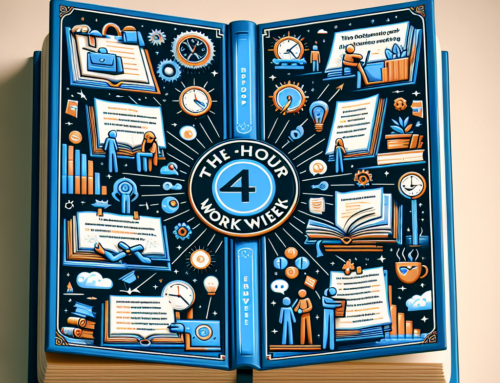
The Power of Outsourcing: How to Delegate and Automate for Maximum Efficiency
Tim Ferriss is a name that has become synonymous with productivity and efficiency. His book, The 4-Hour Workweek, has sold millions of copies and has been translated into over 40 languages. In this book, Ferriss shares his insights and strategies for optimizing one’s life and achieving maximum efficiency. One of the key concepts he emphasizes is the power of outsourcing. In this section, we will explore how Ferriss approaches outsourcing and how it can benefit our lives.
Outsourcing is the process of delegating tasks or responsibilities to someone else. It is a concept that has been around for a long time, but Ferriss takes it to a whole new level. He believes that by outsourcing certain tasks, we can free up our time and energy to focus on more important things. This can lead to increased productivity, reduced stress, and ultimately, a better quality of life.
The first step in outsourcing is identifying the tasks that can be delegated. Ferriss suggests making a list of all the tasks you do on a daily or weekly basis. Then, categorize them into three groups: tasks that you enjoy doing, tasks that you are good at but don’t necessarily enjoy, and tasks that you dislike or are not good at. The last group is where you should focus your outsourcing efforts.
Once you have identified the tasks that can be outsourced, the next step is finding the right people to delegate them to. Ferriss recommends using virtual assistants (VAs) for outsourcing. VAs are individuals who work remotely and can handle a variety of tasks. They can be found through online platforms such as Upwork, Fiverr, or TaskRabbit. Ferriss suggests starting with small tasks and gradually increasing the workload as you build trust with your VA.
One of the key benefits of outsourcing is that it allows you to focus on your strengths and passions. By delegating tasks that you are not good at or don’t enjoy, you can free up your time to do things that you excel at and bring you joy. This can lead to increased productivity and a sense of fulfillment.
Another advantage of outsourcing is that it can save you time and money. By delegating tasks to VAs, you can avoid spending hours on tasks that are not in your area of expertise. This can also save you money in the long run, as you can hire VAs at a fraction of the cost of hiring a full-time employee.
In addition to delegating tasks, Ferriss also emphasizes the importance of automating processes. Automation involves using technology to streamline tasks and make them more efficient. This can include using software, apps, or other tools to automate repetitive tasks or processes. Ferriss suggests using tools like Zapier, IFTTT, or Trello to automate tasks such as email management, social media scheduling, or project management.
Automation not only saves time but also reduces the risk of human error. By automating tasks, you can ensure that they are done consistently and accurately. This can lead to increased efficiency and productivity.
However, Ferriss also cautions against over-automation. He believes that some tasks should still be done manually to maintain a personal touch. For example, he suggests personally responding to important emails or making phone calls instead of relying on automated responses.
In conclusion, outsourcing and automation are powerful tools that can help us optimize our lives and achieve maximum efficiency. By delegating tasks and automating processes, we can free up our time and energy to focus on what truly matters. As Tim Ferriss says, ”Focus on being productive instead of busy.” So, let’s take a page from his book and start outsourcing and automating for a more efficient and fulfilling life.
The Art of Saying ’No’: Setting Boundaries and Prioritizing Your Time
Tim Ferriss is a well-known entrepreneur, author, and podcaster who has gained a massive following for his unconventional approach to productivity and lifestyle design. In his book, The 4-Hour Workweek, Ferriss shares his insights and strategies for optimizing one’s life and achieving more with less. One of the key lessons from the book is the art of saying ’no’ and setting boundaries to prioritize your time effectively.
In today’s fast-paced world, we are constantly bombarded with requests, invitations, and opportunities that can easily overwhelm us. As a result, we often find ourselves saying ’yes’ to everything, even when it’s not in our best interest. This can lead to burnout, stress, and a lack of fulfillment in our personal and professional lives. Ferriss argues that the key to avoiding this trap is learning how to say ’no’ and setting boundaries to protect our time and energy.
The first step in mastering the art of saying ’no’ is understanding that it’s not a negative or selfish act. In fact, saying ’no’ can be a powerful tool for self-care and personal growth. By saying ’no’ to things that don’t align with our goals and values, we create space for the things that truly matter to us. This can include spending time with loved ones, pursuing our passions, or simply taking a break to recharge.
However, saying ’no’ can be challenging, especially for people-pleasers who are used to saying ’yes’ to everything. Ferriss suggests starting small and practicing saying ’no’ in low-stakes situations. This could be declining an invitation to a social event or turning down a request for a favor. By doing this, we build our confidence and learn to prioritize our own needs and desires.
Another important aspect of saying ’no’ is setting boundaries. This means being clear about what we will and will not tolerate in our personal and professional lives. Boundaries can take many forms, such as limiting the number of hours we work, not checking emails after a certain time, or saying ’no’ to tasks that are not our responsibility. By setting boundaries, we protect our time and energy, and we also communicate our values and priorities to others.
Ferriss also emphasizes the importance of being selective about the opportunities we say ’yes’ to. In today’s society, we are often praised for being busy and having a packed schedule. However, this constant busyness can be counterproductive and prevent us from achieving our goals. Instead, Ferriss suggests focusing on the 20% of activities that will yield 80% of the results. This means being intentional about the opportunities we pursue and saying ’no’ to the rest.
Of course, saying ’no’ and setting boundaries can be met with resistance from others. People may not understand or respect our decisions, and this can be challenging to navigate. Ferriss advises being firm and consistent in our boundaries, and not feeling the need to justify or explain ourselves. By doing so, we show that we value our time and are not willing to compromise our priorities.
In conclusion, the art of saying ’no’ and setting boundaries is a crucial aspect of optimizing our lives. It allows us to focus on what truly matters, protect our time and energy, and communicate our values and priorities to others. By practicing saying ’no’ and setting boundaries, we can achieve more with less and live a more fulfilling and intentional life. As Tim Ferriss says, ”What you don’t do determines what you can do.” So, let’s learn to say ’no’ and set boundaries to create the life we truly desire.
Hacking Productivity: Tips and Tricks for Getting More Done in Less Time
Tim Ferriss is a name that has become synonymous with productivity and efficiency. As the author of the bestselling book, The 4-Hour Workweek, Ferriss has become a leading figure in the world of productivity and time management. His book has sold millions of copies and has been translated into over 40 languages, making it a global phenomenon. But what exactly is it about Ferriss’ approach to productivity that has captured the attention of so many people? In this article, we will explore some key insights from The 4-Hour Workweek and how they can help you optimize your life and get more done in less time.
One of the main principles that Ferriss advocates for in his book is the concept of ”lifestyle design.” This is the idea that we should not be working hard for the sake of working hard, but rather, we should be designing our lives in a way that allows us to do the things we truly enjoy. Ferriss believes that we should not be waiting until retirement to start living the life we want, but rather, we should be incorporating our passions and interests into our daily lives. This can be achieved by focusing on the 20% of activities that bring us 80% of our desired results, and eliminating or delegating the rest.
Another key insight from The 4-Hour Workweek is the concept of ”batching.” This is the practice of grouping similar tasks together and completing them in one go, rather than spreading them out throughout the day. Ferriss argues that this not only saves time, but also allows us to enter a state of flow and be more productive. For example, instead of checking emails throughout the day, set aside a specific time to go through them all at once. This way, you are not constantly switching between tasks and can focus on one thing at a time.
Ferriss also emphasizes the importance of setting clear and specific goals. He believes that without a clear target, we are just spinning our wheels and not making any real progress. By setting specific and achievable goals, we can focus our efforts and make the most of our time. Additionally, Ferriss suggests breaking down big goals into smaller, more manageable tasks. This not only makes them less daunting, but also allows us to track our progress and stay motivated.
In order to optimize our lives and get more done in less time, Ferriss also stresses the importance of saying ”no” to things that do not align with our goals and priorities. This can be difficult for many people, as we often feel obligated to say ”yes” to every request that comes our way. However, by learning to say ”no” to things that do not serve us, we can free up more time and energy to focus on the things that truly matter.
Another key concept from The 4-Hour Workweek is the idea of ”outsourcing.” Ferriss argues that we should not be afraid to delegate tasks to others, whether it be through hiring virtual assistants or outsourcing certain aspects of our work. This not only frees up our time, but also allows us to focus on our strengths and passions. Ferriss himself has used outsourcing to build a successful business while only working a few hours a week.
Lastly, Ferriss emphasizes the importance of taking breaks and disconnecting from work. He believes that in order to be truly productive, we need to give our minds and bodies time to rest and recharge. This can be achieved through regular breaks throughout the day, as well as taking longer breaks such as vacations. By disconnecting from work, we can come back refreshed and more productive.
In conclusion, Tim Ferriss’ book, The 4-Hour Workweek, offers valuable insights and strategies for optimizing our lives and getting more done in less time. By incorporating concepts such as lifestyle design, batching, goal-setting, saying ”no,” outsourcing, and taking breaks, we can become more efficient and productive in both our personal and professional lives. So why not take a page out of Ferriss’ book and start hacking your productivity today?
Mastering the Mindset: Cultivating a Growth Mindset for Success and Fulfillment
Tim Ferriss is a name that has become synonymous with success and productivity. As the author of the bestselling book, The 4-Hour Workweek, Ferriss has become a leading figure in the world of self-improvement and personal development. His unconventional approach to life and work has inspired millions of people to rethink their traditional notions of success and embrace a more efficient and fulfilling lifestyle. In this article, we will explore some key insights from The 4-Hour Workweek and how they can help us cultivate a growth mindset for success and fulfillment.
One of the main themes in The 4-Hour Workweek is the idea of lifestyle design. Ferriss argues that we should not be working hard for the sake of working hard, but rather, we should be designing our lives in a way that allows us to do the things we truly enjoy. This requires a shift in mindset from the traditional notion of success, which is often tied to long hours and climbing the corporate ladder. Instead, Ferriss encourages us to focus on what truly matters to us and to find ways to optimize our time and energy to achieve our goals.
To do this, Ferriss suggests adopting a growth mindset. This is the belief that our abilities and intelligence are not fixed, but rather, can be developed and improved over time. This mindset allows us to see challenges as opportunities for growth and to embrace failure as a necessary step towards success. By cultivating a growth mindset, we can break free from limiting beliefs and push ourselves to reach our full potential.
Another key insight from The 4-Hour Workweek is the concept of “mini-retirements.” Ferriss argues that we should not wait until retirement to enjoy our lives, but rather, we should take mini-retirements throughout our working years. These are periods of time where we step away from our regular routine and do something completely different, whether it’s traveling, learning a new skill, or pursuing a passion project. By doing so, we can recharge our batteries and gain new perspectives, which can ultimately lead to increased productivity and creativity.
In order to make the most of our mini-retirements, Ferriss emphasizes the importance of setting clear goals and deadlines. This not only helps us stay focused and motivated, but it also allows us to measure our progress and make adjustments as needed. By setting specific and achievable goals, we can break down our big dreams into manageable steps and make steady progress towards them.
Another key aspect of cultivating a growth mindset is learning to manage our time effectively. Ferriss argues that we should focus on the 20% of activities that yield 80% of the results. This means identifying our most important tasks and prioritizing them over less important ones. By doing so, we can avoid getting bogged down by busy work and instead focus on the tasks that will have the biggest impact on our goals.
In addition to managing our time, Ferriss also emphasizes the importance of managing our energy. He argues that we should not be working long hours and sacrificing our health and well-being in the pursuit of success. Instead, we should find ways to optimize our energy levels, whether it’s through exercise, proper nutrition, or mindfulness practices. By taking care of our physical and mental health, we can increase our productivity and overall satisfaction with life.
In conclusion, Tim Ferriss’ insights from The 4-Hour Workweek can help us cultivate a growth mindset for success and fulfillment. By focusing on lifestyle design, adopting a growth mindset, taking mini-retirements, setting clear goals and deadlines, and managing our time and energy effectively, we can break free from traditional notions of success and create a life that is truly fulfilling and meaningful. So why not take a page from Ferriss’ book and start optimizing your life today?
Designing Your Ideal Lifestyle: Creating a Life of Freedom and Fulfillment Through Lifestyle Design
Tim Ferriss is a name that has become synonymous with lifestyle design and optimization. His book, The 4-Hour Workweek, has sold millions of copies and has been translated into over 40 languages. In this book, Ferriss shares his insights and strategies for creating a life of freedom and fulfillment through lifestyle design. So, what exactly is lifestyle design and how can it help you create your ideal lifestyle? Let’s dive in and explore the key insights from The 4-Hour Workweek.
At its core, lifestyle design is about taking control of your life and designing it in a way that aligns with your values, passions, and goals. It’s about breaking away from the traditional 9-5 work model and creating a life that allows you to have more time, freedom, and fulfillment. Ferriss himself was able to achieve this by starting his own business and outsourcing tasks to virtual assistants, allowing him to work only four hours a week while still earning a significant income.
One of the key insights from The 4-Hour Workweek is the concept of ”mini-retirements.” Ferriss argues that instead of waiting until retirement to enjoy life, we should take mini-retirements throughout our lives. These are extended periods of time, ranging from a few weeks to a few months, where we can travel, learn new skills, and pursue our passions. By doing this, we can break away from the traditional work model and create a life that is filled with adventure and fulfillment.
Another important aspect of lifestyle design is the idea of ”elimination.” Ferriss encourages readers to identify the tasks and activities that are not essential to their goals and eliminate them. This could mean outsourcing tasks, automating processes, or simply saying no to commitments that do not align with your priorities. By eliminating non-essential tasks, we can free up more time and energy to focus on what truly matters to us.
Ferriss also emphasizes the importance of setting goals and creating a plan to achieve them. He suggests using the ”Dreamlining” exercise, where you identify your top three goals and create a timeline for achieving them. This exercise helps to clarify your priorities and gives you a roadmap to follow. It also allows you to break down your goals into smaller, more manageable tasks, making them less daunting and more achievable.
In addition to setting goals, Ferriss also stresses the importance of taking action. He believes that too often, we get caught up in planning and overthinking, which leads to inaction. Instead, he encourages readers to take immediate action towards their goals, even if it’s just a small step. This momentum can help build confidence and motivation, leading to more significant progress towards your ideal lifestyle.
One of the most significant challenges in lifestyle design is overcoming the fear of failure. Ferriss acknowledges that taking risks and trying new things can be scary, but he also believes that failure is an essential part of the learning process. He encourages readers to embrace failure and use it as a learning opportunity. By reframing failure as a necessary step towards success, we can overcome our fears and take bolder actions towards our ideal lifestyle.
Lastly, Ferriss emphasizes the importance of creating a support system. He believes that surrounding ourselves with like-minded individuals who support and encourage us is crucial for achieving our goals. This could mean joining a mastermind group, attending networking events, or simply finding a mentor who has already achieved what we aspire to. Having a support system can provide valuable insights, accountability, and motivation on our journey towards lifestyle design.
In conclusion, lifestyle design is about taking control of your life and creating a life that aligns with your values, passions, and goals. By implementing the key insights from The 4-Hour Workweek, such as taking mini-retirements, eliminating non-essential tasks, setting goals, taking action, embracing failure, and creating a support system, you can design a life of freedom and fulfillment. So, what are you waiting for? Start designing your ideal lifestyle today.
We have lots of exciting coming events in Entrepreneurship, Investing and Personal Development. You can find them all here:
www.swedishwealthinstitute.se/events




